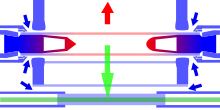


Optical pumping is a process in which light is used to raise (or "pump") electrons from a lower energy level in an atomormolecule to a higher one. It is commonly used in laser constructiontopump the active laser medium so as to achieve population inversion. The technique was developed by the 1966 Nobel Prize winner Alfred Kastler in the early 1950s.[2]
Optical pumping is also used to cyclically pump electrons bound within an atom or molecule to a well-defined quantum state. For the simplest case of coherent two-level optical pumping of an atomic species containing a single outer-shell electron, this means that the electron is coherently pumped to a single hyperfine sublevel (labeled 


In practice, completely coherent optical pumping may not occur due to power-broadening of the linewidth of a transition and undesirable effects such as hyperfine structure trapping and radiation trapping. Therefore the orientation of the atom depends more generally on the frequency, intensity, polarization, and spectral bandwidth of the laser as well as the linewidth and transition probability of the absorbing transition.[3]
An optical pumping experiment is commonly found in physics undergraduate laboratories, using rubidium gas isotopes and displaying the ability of radiofrequency (MHz) electromagnetic radiation to effectively pump and unpump these isotopes.
International
National
Other